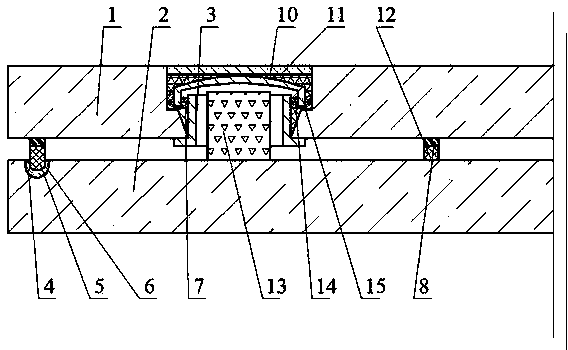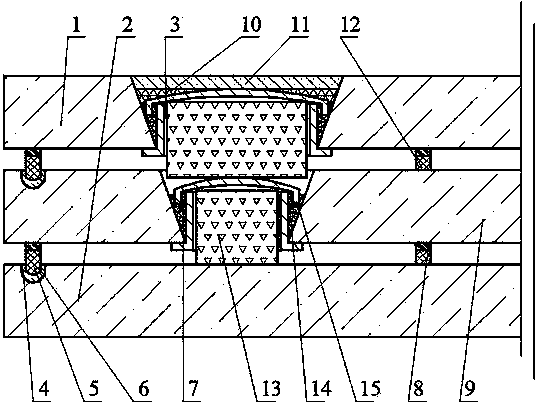Microwave-welded flat tempered vacuum glass edge-sealed with sealing groove and having getter
A vacuum glass and microwave welding technology, applied in glass production, glass forming, glass re-molding and other directions, can solve the problems of small space, affecting the appearance, complicated getter encapsulation and placement process, etc.
- Summary
- Abstract
- Description
- Claims
- Application Information
AI Technical Summary
Problems solved by technology
Method used
Image
Examples
Embodiment 1
[0073] Embodiment 1: see figure 1The tempered vacuum glass consists of upper glass 1 and lower glass 2. The two pieces of glass are tempered glass or semi-tempered glass, one of which is low-emissivity glass. A piece of flat glass and a piece of low-emissivity glass of the same size, the low-emissivity glass is selected as the lower glass 2, a tapered through hole is drilled at the corner of the upper glass 1 as the air inlet 3, and a sealing groove 6 is opened on the periphery of the lower glass 2, and Carry out edging, chamfering, cleaning, and drying, and use the screen printing technology to print the sealing strip with tempered glass ink on the peripheral welding of the upper glass 1 and print the support 8 at the same time; secondly, send the two pieces of glass into the tempering furnace Air-cooled tempering is carried out under the same conditions to obtain tempered or semi-tempered glass; at the same time, high polymer 12 is prepared, and high polymer 12 is polyimide....
Embodiment 2
[0074] Example 2: see figure 2 The double-vacuum-layer tempered vacuum glass consists of upper glass 1, middle glass 9 and lower glass 2. Among the three pieces of glass, at least the upper and lower glasses are tempered glass or semi-tempered glass, and the lower glass 2 or \and the middle glass 9 are still low. Radiation glass, its production method is as follows: First, according to the shape and size of the vacuum glass to be produced, cut three pieces of flat glass of the required size, and drill a tapered through hole on the upper glass 1 and the middle glass 9 respectively to form the air inlet 3 , wherein the through hole on the upper glass 1 is larger than the through hole on the middle glass 9, and the metal round tubes with lower end flanges are prepared and inserted into the air outlet, and the outer sides of the lower part of the round tube are closely matched with the lower ends of the air outlet 3 respectively, and the circle The upper part of the pipe and the ...
PUM
 Login to View More
Login to View More Abstract
Description
Claims
Application Information
 Login to View More
Login to View More - R&D
- Intellectual Property
- Life Sciences
- Materials
- Tech Scout
- Unparalleled Data Quality
- Higher Quality Content
- 60% Fewer Hallucinations
Browse by: Latest US Patents, China's latest patents, Technical Efficacy Thesaurus, Application Domain, Technology Topic, Popular Technical Reports.
© 2025 PatSnap. All rights reserved.Legal|Privacy policy|Modern Slavery Act Transparency Statement|Sitemap|About US| Contact US: help@patsnap.com


